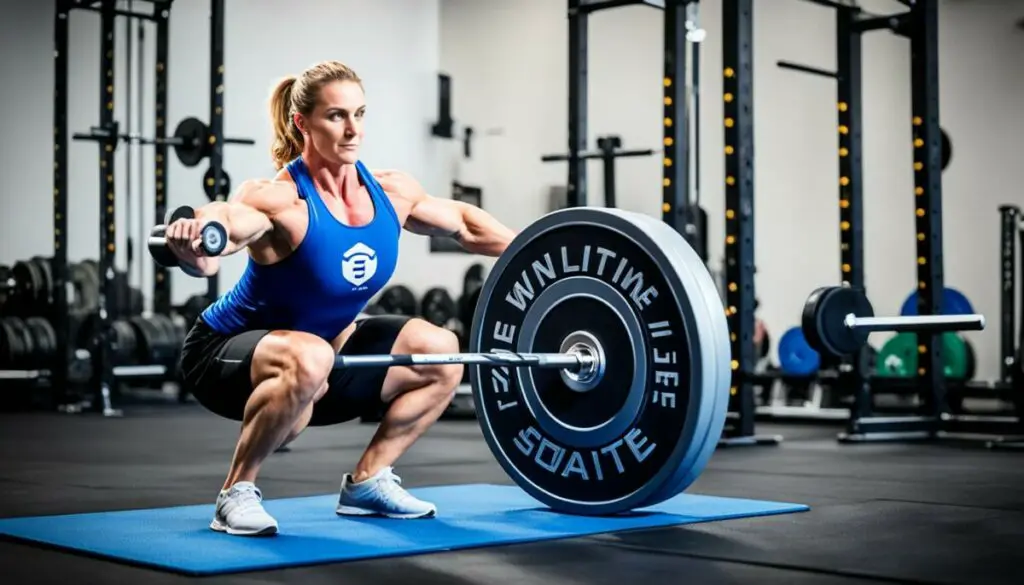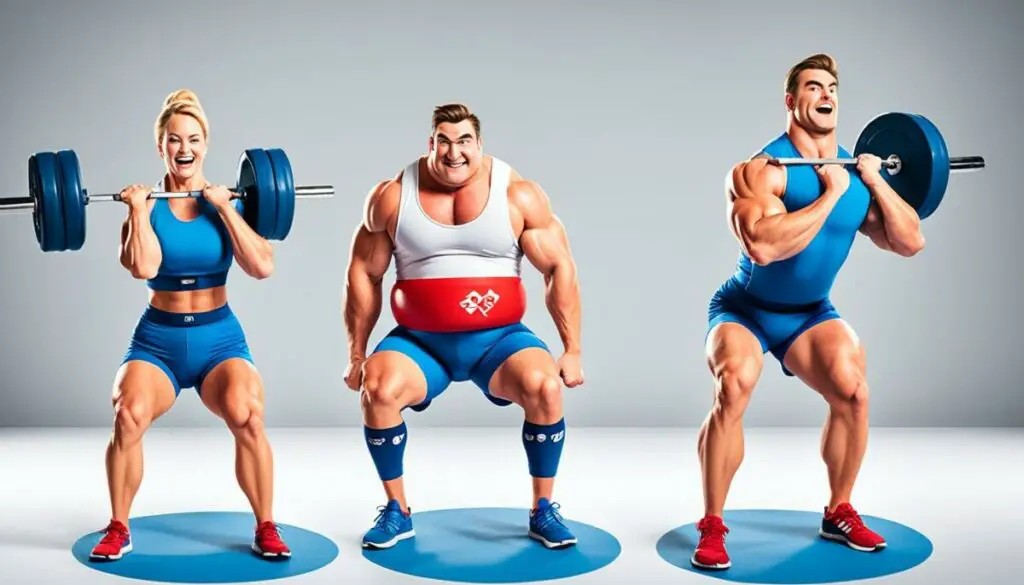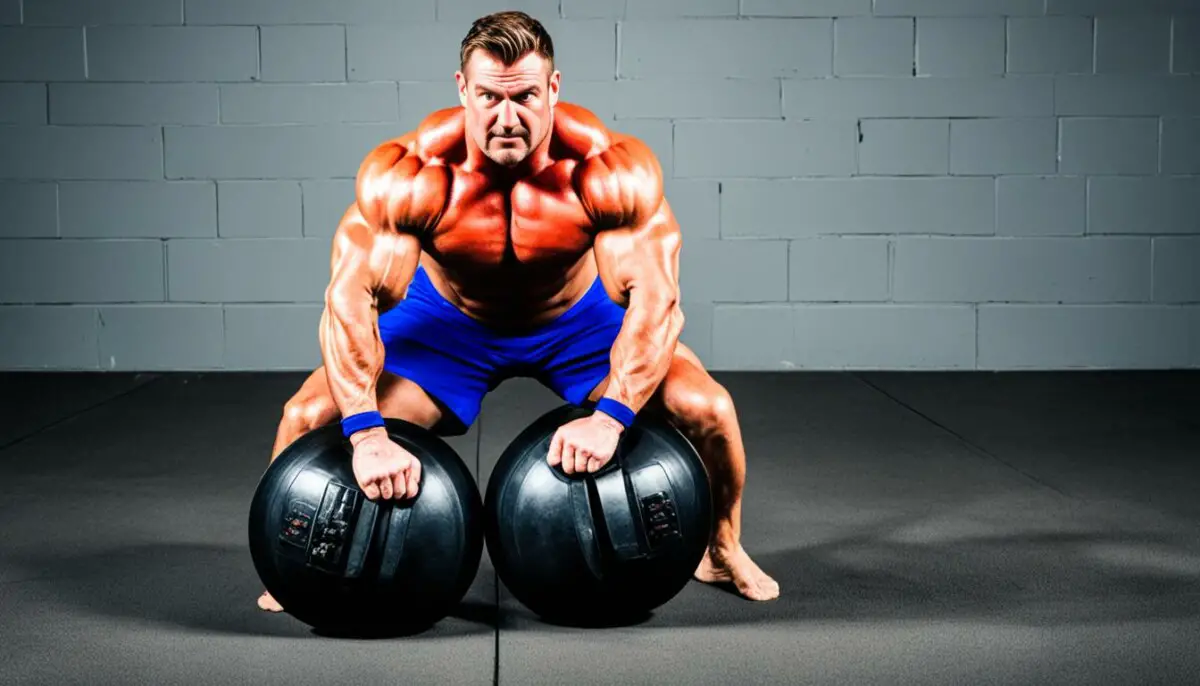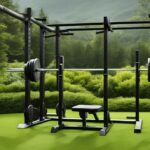Last Updated on 3 months by Francis
The landmine sumo squat is a powerful exercise that can elevate your leg day workouts. By incorporating this movement into your routine, you can target and strengthen your glutes and legs. It is a versatile exercise that can be modified to suit your fitness level and goals.
Contents
Key Takeaways:
- The landmine sumo squat is an effective exercise for targeting and strengthening the glutes and legs.
- It is a versatile exercise that can be modified to suit different fitness levels and goals.
- By incorporating the landmine sumo squat into your leg day workouts, you can add variety and challenge your muscles in new ways.
- This exercise can help improve lower body strength, stability, and muscle balance.
- Remember to always prioritize proper form and gradually increase the intensity and weight as you progress.
Introduction to the Landmine Attachment

!
The landmine attachment is a versatile piece of gym equipment that can revolutionize your leg day lifts. Invented by Bert Sorin in 1999, the landmine attachment has gained popularity in both commercial and home gyms due to its effectiveness and functionality. This joint-friendly equipment allows for a wide range of movements, promotes good form, and offers rotational exercises beyond the traditional sagittal plane.
With the landmine attachment, your leg day workouts become more dynamic and engaging, targeting multiple muscle groups while minimizing strain on your joints. Its versatility as a piece of equipment enables you to incorporate various exercises to enhance your lower body strength and stability.
Whether you’re aiming to build stronger quads, sculpt your glutes, or improve your overall leg strength, the landmine attachment is a game-changer. Its unique design and functionality make it a valuable tool for anyone looking to take their leg day workouts to new heights.
| Benefits of the Landmine Attachment | Examples of Exercises |
|---|---|
| Allows for joint-friendly movements | Landmine sumo squat |
| Promotes good form | Landmine reverse lunge |
| Provides rotational movements | Landmine Romanian deadlift |
| Enhances lower body strength | Landmine step-up |
| Improves stability and balance | Landmine single-leg squat |
Investing in a landmine attachment can significantly diversify your leg day workouts and bring a new level of challenge and effectiveness to your fitness routine. Its versatility, joint-friendly nature, and ability to provide rotational movements make it a must-have for anyone seeking to maximize their leg day gains.
Discover the endless possibilities with the landmine attachment and unlock your full leg day potential!
Benefits of the Landmine Sumo Squat

The landmine sumo squat offers several benefits that can enhance your leg development and overall workout routine. Let’s explore these benefits in detail:
Easier on Joints and Spine
The landmine sumo squat is a modified version of the traditional squat that reduces stress on your joints and spine. By adopting a wider stance and pointing your toes outward, you can minimize strain on the knees and lower back. This makes it an excellent choice for individuals with joint issues or those looking for a more joint-friendly exercise.
Anterior and Posterior Loading
One of the unique advantages of the landmine sumo squat is that it can be loaded in both anterior and posterior positions. This means that you can hold the weight in front of your body or place it behind your neck, targeting different muscle groups for balanced and effective leg development. It allows you to diversify your training and challenge your muscles in new ways.
Proprioceptive Challenges
Incorporating the landmine sumo squat into your workout routine introduces proprioceptive challenges. The wider grip point of the barbell requires increased stability and control, engaging muscles responsible for balance and coordination. This not only strengthens the targeted leg muscles but also improves overall proprioception, leading to better body awareness and movement control.
Enhanced Grip Strength
The landmine sumo squat can contribute to the development of grip strength. With the wider grip point of the barbell, your forearms, wrists, and hand muscles are engaged to maintain a secure hold throughout the exercise. Over time, this can improve your grip strength, benefiting various other exercises and daily activities that require a strong grip.
To summarize, the landmine sumo squat offers several benefits, including reduced strain on joints and spine, versatility in loading options, proprioceptive challenges, and improved grip strength. Incorporating this exercise into your leg day workouts can contribute to your overall leg development and enhance your fitness journey.
How to Perform a Landmine Sumo Squat

To effectively perform a landmine sumo squat, follow these steps:
Step 1: Set up the landmine attachment by positioning it securely in a corner or using a landmine base attachment. Place the barbell into the landmine attachment, ensuring it is stable and won’t move during the exercise.
Step 2: Stand with your feet wider than shoulder-width apart and angle your toes outward at approximately a 45-degree angle.
Step 3: Position yourself facing the barbell, with the bar placed between your legs at the center of your feet.
Step 4: Grasp the barbell with both hands, maintaining an overhand grip slightly wider than shoulder-width apart.
Step 5: Lower your body into a squatting position by bending your knees and pushing your hips back. Keep your chest upright and proud, with your back in a neutral position.
Step 6: Continue to lower your body until your thighs are parallel to the ground, or as far as your flexibility allows.
Step 7: Drive through your heels and engage your glutes and leg muscles to push the weight up. Extend your legs and return to the starting position.
Step 8: Repeat the movement for the desired number of repetitions.
Remember to maintain control and focus on proper form throughout the exercise. Here’s a visual reference to help you with the execution:
“The landmine sumo squat is a compound exercise that engages multiple muscle groups, targeting the glutes, quadriceps, hamstrings, and adductors. It’s a great way to build lower body strength and improve overall stability.”
By incorporating the landmine sumo squat into your leg day routine, you can effectively target and strengthen your lower body muscles. Remember to start with lighter weights and gradually increase the intensity as you become more comfortable with the exercise. Now that you know how to perform a landmine sumo squat correctly, let’s explore some variations to further challenge and diversify your workouts.
Landmine Sumo Squat Variations

Looking to add some variety to your leg day workouts? Try incorporating these landmine sumo squat variations to target different muscles and add an extra challenge to your routine. Take a look at some examples below:
Heel-Elevated Squats to Press
Elevating your heels during the landmine sumo squat adds an extra level of difficulty by targeting your calves and increasing the range of motion. Perform the squat as usual, but with your heels raised on a weight plate or small platform. As you rise back up, press the weight overhead, engaging your shoulders and upper body.
Squat to Lateral Step
Integrate lateral movements into your leg day by combining the landmine sumo squat with a lateral step. After completing each squat, step laterally to the right or left, engaging your glutes, hips, and inner and outer thigh muscles. Return to the starting position and repeat on the opposite side.
Underhand Grip Sumo Squats
Varying your grip in the landmine sumo squat can target different muscles in your upper body. Try using an underhand grip on the barbell, which engages your biceps and forearms while still working your lower body. This variation is a great way to challenge your grip strength and promote balanced muscle development.
These are just a few examples of landmine sumo squat variations you can incorporate into your leg day routine. Feel free to get creative and experiment with different grips, stances, and movements to keep your workouts engaging and effective.
| Variation | Focused Muscles | Description |
|---|---|---|
| Heel-Elevated Squats to Press | Quadriceps, glutes, shoulders, calves | Elevate your heels on a weight plate or platform and perform sumo squats. On the way up, press the weight overhead. |
| Squat to Lateral Step | Quadriceps, glutes, hips, inner and outer thighs | Complete a sumo squat, then take a lateral step to the right or left. Return to the starting position and repeat on the other side. |
| Underhand Grip Sumo Squats | Quadriceps, glutes, hamstrings, biceps, forearms | Perform sumo squats with an underhand grip on the barbell, engaging your upper body muscles in addition to the lower body. |
Muscles Worked by the Landmine Sumo Squat

The landmine sumo squat is an effective exercise that engages multiple muscle groups in the lower body. By incorporating this exercise into your leg day routine, you can target and strengthen the following muscles:
- Quadriceps: The landmine sumo squat primarily works the quadriceps, the large muscle group located in the front of the thigh. This exercise helps to develop strength and power in the quads, contributing to improved lower body performance.
- Glutes: The glutes, which consist of the gluteus maximus, medius, and minimus, are also heavily engaged during the landmine sumo squat. This exercise can help to build strength and shape in the glute muscles, contributing to a rounder and more defined buttocks.
- Hamstrings: The hamstrings, located at the back of the thigh, are activated as stabilizers during the landmine sumo squat. This exercise helps to develop strength and stability in the hamstrings, contributing to improved lower body balance.
- Adductors: The adductors, a group of muscles on the inner thigh, are effectively targeted during the landmine sumo squat. This exercise helps to strengthen and tone these muscles, promoting improved hip stability and reducing the risk of injury.
- Hip Flexors: The hip flexors, which include muscles such as the psoas and iliacus, play a supporting role in the landmine sumo squat. They help to stabilize the pelvis and assist in the movement of the legs during this exercise.
The landmine sumo squat offers a comprehensive workout for the lower body, targeting both large and small muscle groups. By regularly incorporating this exercise into your fitness routine, you can improve lower body strength, stability, and overall muscle tone.
| Muscle Group | Primary Function |
|---|---|
| Quadriceps | Leg extension and stabilization |
| Glutes | Hip extension and stabilization |
| Hamstrings | Leg flexion, hip extension, and stabilization |
| Adductors | Leg adduction and stabilization |
| Hip Flexors | Hip flexion and pelvic stabilization |
Differences Between Landmine Squat and Goblet Squat

The landmine squat and goblet squat are two popular variations of the squat exercise that target the lower body muscles. While both exercises provide numerous benefits, there are notable differences between them that make each unique.
Landmine Squat
The landmine squat involves using a barbell attached to a landmine, which allows for controlled movement and stability. This exercise challenges the lower body muscles, including the quadriceps, glutes, hamstrings, and calves, while providing additional rotational movements.
One of the benefits of the landmine squat is its capacity to offer grip strength challenges. The wider grip point of the barbell forces you to engage your forearms and develop your grip strength throughout the movement.
Furthermore, the landmine squat can be suitable for individuals who struggle with a traditional squat due to mobility issues or limited range of motion. The angled position of the barbell can alleviate stress on the lower back and knees, making it a joint-friendly alternative.
Goblet Squat
The goblet squat, on the other hand, involves holding a dumbbell or kettlebell close to your chest with both hands. This exercise allows for a more upright torso position, placing a greater emphasis on core engagement.
With the weight positioned in front of your body, the goblet squat challenges your stability and encourages proper form by keeping your chest lifted and your hips aligned. It primarily targets the quadriceps, glutes, and core muscles, making it an effective exercise for building lower body strength and improving overall stability.
Unlike the landmine squat, the goblet squat does not provide rotational movements or grip strength challenges. However, it offers a more accessible and beginner-friendly option for individuals who are new to squatting exercises or have limited equipment available.
Comparing the Landmine Squat and Goblet Squat
To summarize, here is a comparison between the landmine squat and goblet squat:
| Exercise | Equipment | Main Muscles Targeted | Additional Benefits |
|---|---|---|---|
| Landmine Squat | Barbell attached to landmine | Quadriceps, glutes, hamstrings, calves | Rotational movements, grip strength challenges, joint-friendly |
| Goblet Squat | Dumbbell or kettlebell | Quadriceps, glutes, core | Upright torso position, core engagement |
Ultimately, the choice between the landmine squat and goblet squat depends on your individual goals, preferences, and equipment availability. Both exercises can be effective additions to your lower body workout routine, helping you strengthen and tone your legs, glutes, and core muscles.
*Note: The image above illustrates the differences between the landmine squat and goblet squat.
Tips for Proper Form in the Landmine Sumo Squat

To perform the landmine sumo squat with proper form, follow these tips:
- Maintain a wide stance with your toes pointed outwards. This will target your glutes, hips, and inner thighs effectively.
- Keep your chest proud throughout the movement. This will help you maintain an upright posture and engage your core muscles.
- Ensure your neck and spine are neutral. Avoid rounding or arching your back, as this can lead to strain and injuries.
- Keep your shoulders back and down. This will help stabilize your upper body and prevent unnecessary stress on your neck and shoulders.
- Consider lifting the weight by standing on bumper plates or low boxes. This will increase the range of motion and challenge your muscles further.
Remember, proper form is crucial for maximizing the benefits of the landmine sumo squat and minimizing the risk of injuries. Take your time to master the technique and start with lighter weights before progressing to heavier loads. Consult a fitness professional if you’re unsure about your form or technique.
Image: A visual representation of proper form in the landmine sumo squat exercise.
The Benefits and Limitations of Landmine Leg Exercises
Landmine leg exercises offer several benefits that can enhance your leg day workouts. These exercises provide variety to your routine, challenge your muscles in new ways, and improve balance and stability. However, it is important to consider the limitations of landmine leg exercises as well. Let’s take a closer look at the benefits and limitations of incorporating these exercises into your leg day routine.
Benefits of Landmine Leg Exercises
Adding landmine leg exercises to your workout routine can bring several advantages:
- Variety: Landmine exercises allow you to diversify your leg workouts, preventing monotony and keeping your routine interesting.
- Muscle Challenges: Landmine leg exercises engage your muscles in unique ways, targeting different angles and emphasizing different muscle groups than traditional barbell exercises.
- Balance and Stability: The instability created by landmine exercises forces your body to engage its stabilizer muscles, improving overall balance and stability.
Limitations of Landmine Leg Exercises
While landmine leg exercises offer numerous benefits, there are some limitations to be aware of:
- Weight Limitations: Compared to traditional barbell exercises, landmine exercises may limit the amount of weight you can use, particularly for lower body movements.
- Equipment Requirement: To perform landmine leg exercises, you need access to a landmine attachment, which may not be available in all gyms or home setups.
Despite these limitations, landmine leg exercises can still be a valuable addition to your leg day routine. The benefits they offer in terms of variety, muscle challenges, and balance/stability make them worth incorporating into your workouts. Just be mindful of the weight limitations and ensure you have access to the necessary equipment.
| Benefits | Limitations |
|---|---|
|
|
Muscles Worked by Landmine Leg Exercises
Landmine leg exercises are highly effective for targeting and strengthening various muscles in the lower body. Incorporating a variety of these exercises into your routine can provide balanced development and enhance your leg day workouts.
The following table highlights the specific muscles targeted by different landmine leg exercises:
| Exercise | Muscles Worked |
|---|---|
| Landmine Squat | Quadriceps, Glutes, Hamstrings, Calves |
| Landmine Lunge | Quadriceps, Glutes, Hamstrings, Calves |
| Landmine Romanian Deadlift (RDL) | Hamstrings, Glutes, Lower Back |
| Sumo Squat (Landmine or Rig Attachment) | Quadriceps, Adductors, Glutes, Hamstrings, Calves |
| Landmine Step-Up | Quadriceps, Glutes, Hamstrings, Calves |
These exercises engage the listed muscles to varying degrees, depending on the specific movement patterns and joint angles involved. By incorporating a combination of squats, lunges, and deadlift variations into your landmine leg exercise repertoire, you can effectively target and strengthen the major muscle groups in your lower body.
It’s important to note that the range of motion and muscle activation may differ slightly between individuals due to factors such as flexibility, form, and technique. Adjusting the intensity, load, and rest periods can further customize the workout to suit your fitness level and goals.
In addition to the muscles mentioned in the table, landmine leg exercises also activate stabilizer muscles in the hips, core, and lower back, contributing to overall strength and stability.
By including a variety of landmine leg exercises in your training routine, you can effectively work multiple muscle groups, promote functional movement patterns, and attain well-rounded lower body strength and development.
Landmine Leg Exercises: Squat, Lunge, and RDL Variations
When it comes to landmine leg exercises, there are three main types to explore: squat variations, lunge variations, and Romanian deadlift (RDL) variations. Each variation offers unique challenges and targets different muscles in the lower body. Let’s take a closer look at these variations and how they can enhance your leg day workouts.
Squat Variations
Squats are a staple exercise for leg development, and landmine squat variations add an extra dimension to your routine. Here are a few options to consider:
- Landmine Squat: A classic squat variation that targets the quadriceps, glutes, and hamstrings.
- Sumo Squat: This variation places more emphasis on the inner thighs and gluteus medius.
- Hack Squat: By positioning the weight behind you, the hack squat variation further engages the quads and glutes.
Lunge Variations
Lunges are excellent for strengthening the lower body and improving balance. With the landmine attachment, you can try these lunge variations:
- Landmine Lunge: This variation targets the quads, hamstrings, glutes, and calves, providing a complete lower body workout.
- Reverse Lunge: By stepping backward, you activate different muscles and challenge stability.
- Side Lunge: The side lunge variation engages the adductors and obliques, promoting overall lower body strength and flexibility.
RDL Variations
Romanian deadlifts (RDLs) are effective exercises for targeting the posterior chain and improving hamstring and glute strength. Here are some landmine RDL variations to try:
“The landmine RDL is a fantastic exercise for developing hip hinge mechanics while placing emphasis on the hamstrings and glutes.” – Fitness Expert
| Landmine RDL Variations | Muscles Targeted | Description |
|---|---|---|
| Landmine RDL | Hamstrings, Glutes | Targets the posterior chain while minimizing stress on the lower back. |
| Alternate Landmine RDL | Hamstrings, Glutes | Focuses on unilateral strength and stability, challenging each leg individually. |
| Single-Leg Landmine RDL | Hamstrings, Glutes, Core | Enhances balance, stability, and overall lower body strength by working one leg at a time. |
By incorporating these landmine squat, lunge, and RDL variations into your leg day workouts, you can target different muscle groups, promote balance and stability, and take your leg training to the next level.
Stay tuned for the upcoming sections, where we’ll delve into the specific muscles worked by these landmine leg exercises and provide tips for proper form and execution.
Conclusion
Incorporating landmine leg exercises into your leg day workouts can greatly enhance your lower body training and help you achieve exceptional glute and leg gains. The versatility of these exercises, such as the landmine sumo squat, allows you to target and strengthen multiple muscles in your lower body, including the quadriceps, glutes, hamstrings, adductors, and calves.
To maximize the benefits of landmine leg exercises, it is critical to prioritize proper form. Maintain a wide stance, keep your chest proud, and ensure your spine and neck stay neutral throughout each movement. Gradually increase the intensity and weight as your strength and fitness level progresses.
Landmine leg exercises provide a refreshing change to your leg day routine, offering a variety of movements beyond traditional barbell exercises. Although there are certain limitations, such as the need for a landmine attachment and the inability to go as heavy as with traditional squats, the benefits outweigh the drawbacks. By incorporating landmine leg exercises into your routine, you can challenge your muscles in new ways and improve your balance and stability.
FAQ
What is a landmine attachment?
A landmine attachment is a versatile piece of gym equipment that can be used for various exercises, including leg day lifts. It allows for joint-friendly movements, encourages good form, and provides rotational movements beyond the sagittal plane.
What are the benefits of the landmine sumo squat?
The landmine sumo squat offers several benefits, including being easier on the joints and spine compared to traditional squats, challenging your legs in a new way, and helping to identify and correct muscle imbalances. It can also contribute to grip strength due to the wider grip point of the barbell.
How do I perform a landmine sumo squat?
To perform a landmine sumo squat, you start by setting up the landmine attachment and placing the barbell between your legs. Adopt a wide stance with your toes pointed outwards, then squat down by bending your knees and pushing your hips back. Lift the weight by pushing through your feet and extending your legs, then lower back into the squat and repeat for the desired number of repetitions.
What are some variations of the landmine sumo squat?
There are several variations of the landmine sumo squat that you can try, including heel-elevated squats to press, squat to lateral step, and underhand grip sumo squats. These variations can target different muscles and provide additional challenges to your workout routine.
Which muscles does the landmine sumo squat work?
The landmine sumo squat targets multiple muscle groups in the lower body, including the quadriceps, glutes, hamstrings, adductors, and hip flexors. It engages these muscles to a greater extent compared to traditional squats and helps improve overall lower body strength and stability.
What are the differences between the landmine squat and goblet squat?
The landmine squat involves using a barbell attached to a landmine, while the goblet squat involves holding a dumbbell or kettlebell close to your chest. The landmine squat can offer more rotational movements and challenges for grip strength, while the goblet squat allows for a more upright torso position and greater core engagement.
What are some tips for proper form in the landmine sumo squat?
To maintain proper form in the landmine sumo squat, it’s important to maintain a wide stance with your toes pointed outwards, keep your chest proud, your neck and spine neutral, and your shoulders back throughout the movement. Consider lifting the weight by standing on bumper plates or low boxes to increase the range of motion and challenge your muscles further.
What are the benefits and limitations of landmine leg exercises?
Landmine leg exercises offer several benefits, including adding variety to workouts, challenging muscles in new ways, and improving balance and stability. However, there are also limitations to consider, such as the inability to go as heavy as traditional barbell exercises and the need for a landmine attachment.
Which muscles are worked by landmine leg exercises?
Landmine leg exercises target various muscles in the lower body, including the quadriceps, glutes, hamstrings, adductors, and calves. Different exercises within the landmine leg exercise repertoire may emphasize certain muscles more than others.
What are the different types of landmine leg exercises?
Landmine leg exercises can be categorized into three main types: squat variations, lunge variations, and Romanian deadlift (RDL) variations. Squat variations include the landmine squat, sumo squat, and hack squat. Lunge variations include the landmine lunge, reverse lunge, and side lunge. RDL variations include the landmine RDL, alternate landmine RDL, and single-leg landmine RDL.
How can landmine leg exercises enhance leg day workouts?
By incorporating landmine leg exercises, such as the landmine sumo squat, into your routine, you can enhance your leg day workouts and achieve superior glute and leg gains. These exercises offer a variety of movements to target and strengthen the lower body muscles.









